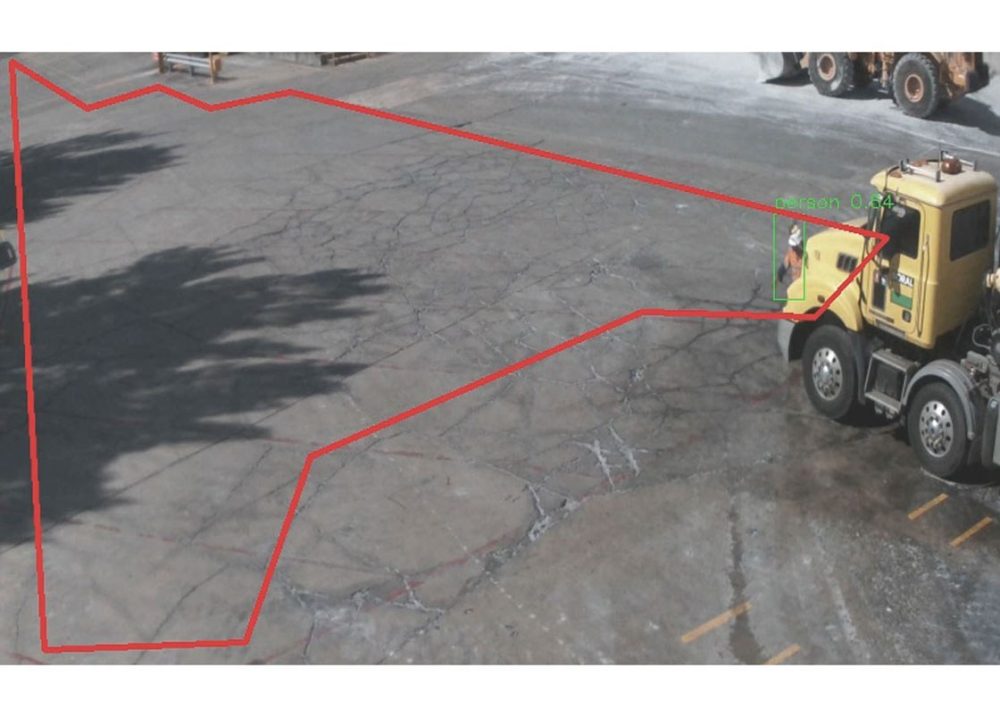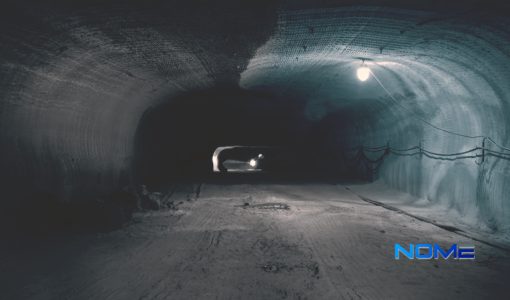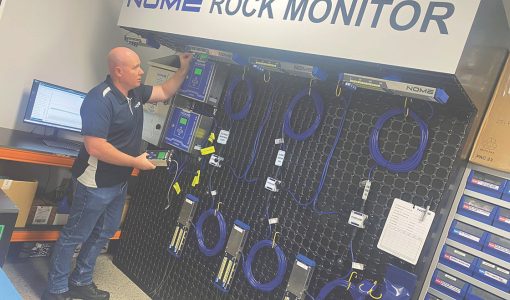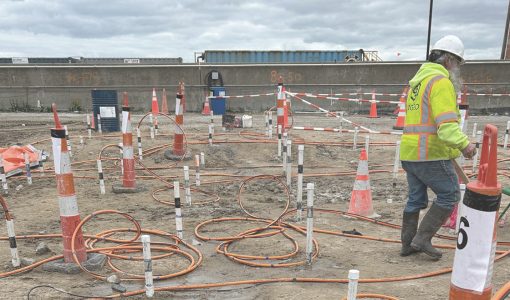How are personnel moving throughout your job site or yard? Are pedestrians following marked or instructed routes, intended to help them avoid danger from vehicle and equipment traffic?
According to pedestrian data collected on several sites by Strata’s SafeSITE™ artificial intelligence technology platform, most people follow the marked pathways, adhering to safety protocols. However, some do choose to take the shortest perceived route even if it might be hazardous due to vehicle traffic and blind spots. These unfortunate decisions sometimes lead to tragic incidents that result in injury or loss of life.
New AI-driven proximity vision sensors, part of the HazardAI™ family of proximity technologies, create “exclusion zones” that deter pedestrians from entering unsafe areas by sounding a real-time auditory alarm and visual flasher when they break the threshold. Detection of these breaches allows managers of mine sites, tunneling operations, and maritime port terminals, to improve workplace safety compliance and collect critical data that can inform greater efficiency and workflows.
“The system is a tool for the site leadership to reduce unsafe behavior over a sustained period of time,” Martin Guenzl, Visual Technology Specialist for Strata Worldwide. “The image snapshot taken at the alert detection time provides context to the site leader to assess what occurred and who was involved, based on their knowledge.”
Identifying Exclusion Zones
The technology was born out of a single tragic incident where an experienced and trained worker engaging in routine actions in a relatively light traffic area was struck and killed by a vehicle. The truck driver parked his rig in a designated spot next to one of only two other trucks in the yard. Walking the route to the office he’d followed for years to sign in, he walked around the truck he’d parked beside and was run over by the third, losing his life. What had been perceived as safe and routine had been a serious workplace safety issue waiting to happen.
Unsafe practices and pedestrian routes often become routine and even trained behaviors. Bringing an outside consultant to assess and identify potential hazards will reveal safety exposures of the operation. Once these vulnerable areas are recognized, mechanisms can be put in place to not only collect data but also correct unsafe behaviors. These mechanisms include pedestrian exclusion zones to prevent foot traffic into hazardous areas, blind spot protection to avert pedestrians from areas with vehicle traffic, and digital gates or fencing to control pedestrian traffic flow.
Strata’s SafeSITE™ FixedAI full service and support offering includes experienced consultation followed by professional installation, configuration, and optimization of systems for best results.
Creating Exclusion Zones
The FixedAI “camera” works on vision-based AI with a configurable exclusion area marked in the field of view. The zones are mapped individually by operators and can be customized in creative pathways for crosswalks or breaks that allow foot traffic to safely pass through.
Cameras are mounted more than 5 meters (>16 feet) high to avoid obstructions like parked or passing vehicles. The AI can accurately detect people from all angles, including directly above, covering an area as large as 1,800 square meters (~19,000 sq. ft.).
FixedAI has two choices of lenses. A standard 58-degree lens typically covers an area of ~50m (~164 ft) deep by ~35m (114 ft) wide. The wide-angle 110-degree lens flips those dimensions making the view ~35m (114 ft) deep by ~50m (~164 ft) wide. Depending on other factors such as light conditions, sensor angle, etc. detection has been successful at further distances.
Strata experts will help identify mounting and positioning. Placement planning optimizes the results by:
• Reducing the frequency of a vehicle or other object obscuring the view of the exclusion area.
• Minimizing false positives from side-view mirror reflections and standing water.
• Targeting the full coverage of the exclusion area by one camera if possible.
Data-Driven Safety
Field tests have shown that using cameras with AI technology with real-time warning alarms, such as Strata’s FixedAI, create a lasting deterrent for unsafe behaviors. “Exclusion zones can be physically marked areas on the ground and reinforced with signage,” said Guenzl. “Analysis reveals however, that although physical markings do help direct foot traffic away from unsafe places initially, this is a temporary measure that is easily overlooked or ignored over time.”
The mySafeSITE™ backend platform is the central hub for system data. Accessed via the internet or through the mobile app, managers/supervisors receive alerts for the entire site or specific zones for which they’re responsible whenever a zone breach occurs. Operators can control and monitor the system from anywhere on any mobile or desktop device.
The FixedAI technology is a self-contained unit with working firmware and software. Collected data can be sent directly to the platform via Wi-Fi or standalone LTE (preferred so alerts can be immediately sent to stakeholders via the mySafeSITE platform/app). Software and firmware updates are done remotely with no downtime.
Although the AI system is vision-based (via the camera), there is no facial recognition technology or requirement for a worn sensor. It works on trained datasets of humans either full body or parts of the body not-only moving into an exclusion zone, but also near the zone line and creates a data point for each.
Data-Supported Workplace Safety Policies
Workplace safety policy can be proactive and specific to the site or facility. Federal and local regulations are painted with a wide stroke and may not pinpoint hazards specific to your workplace. Setting policies based on a set of assumptions drawn from experience and set within the regulatory guidelines is an excellent place to start. However, those policies need to be malleable based on current conditions and hard data. To proactively prevent hazards, data will reveal patterns that identify potentially dangerous behavior and drive new policies.
A core advantage to FixedAI, along with the audio and visual alerts, is the data collected. Site supervisors engage with the alerts to classify them according to risk. A scatter plot of activity can be generated over a given period showing the traffic in proximity to and crossing the threshold of the exclusion zone. Key performance indicators (KPIs) and trends are then published on a site-by-site and aggregated basis to monitor improvements or focus areas. Finally, the data and images are fed back into the AI model to maintain high detection accuracy across a broad range of situations. The AI can handle unique HSE/OSHA requirements that produce alerts for site managers that are relevant and actionable.
Accessed anytime on the mySafeSITE platform, there are three general reports that are generated to help operators understand and monitor safety and progress.
• Weekly Digest – When and where breaches and sensor detections. Managers can then submit further thoughts, generate incident reports, or perform disciplinary actions.
• Monthly Report – This provides a more traffic-based result that might pinpoint variations in behavior needed by shift, zone, or activity.
• Quarterly Insights – A broad overview can help characterize the status of workplace safety and drive decision-making at the enterprise level.
Results
“After installing and testing the final product in real-world settings where the customer was in charge of the interface and operation of the technology, they were able to achieve an average of 5x decrease in risky recorded events,” Guenzl pointed out. “This was the average across zones and sites, which highlights the behavioral modification power of this technology.
Rugged and Well-Protected
With multiple hardware configuration options, the standard cameras and hard drives are housed in a self-contained IP67-rated casing sealed from punishing weather, bugs, and birds. This sealed environment allows them to be cleaned by a power washer from a distance.
In the event of heavy weather or a natural disaster, the FixedAI unit remains functional, and data can be retrieved directly from it. This allows operators to examine forensic visual evidence of incidents.
The Future of Workplace Safety
Vehicle collisions are one of the most common workplace injuries that is shared across industries and countries. Working around large machinery requires awareness, training, and vigilance on behalf of personnel, but distractions and other factors do exist. This is where visual and auditory alerts are helpful. Using AI to support workplace safety, managers and executive stakeholders will be able to use real-time data to inform policies and procedures that prevent workplace injuries and improve compliance.



